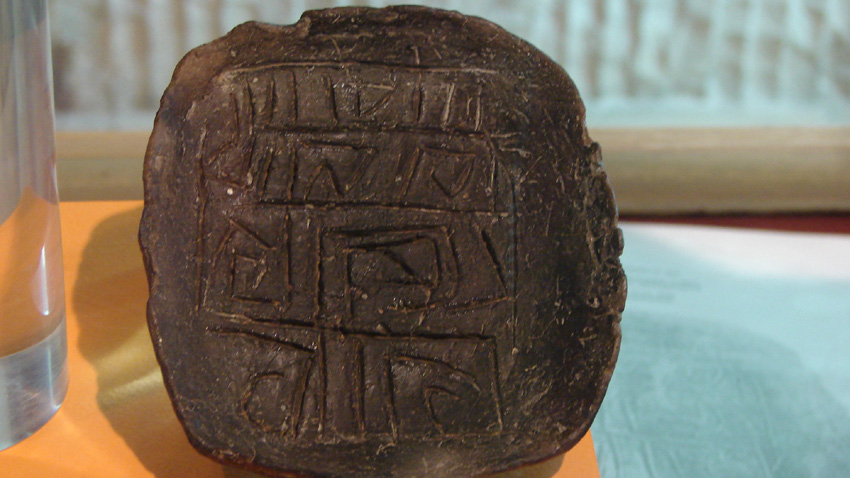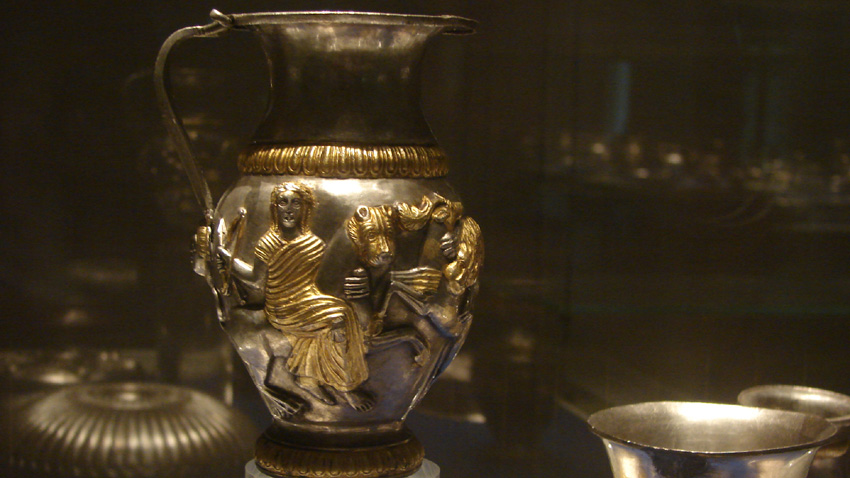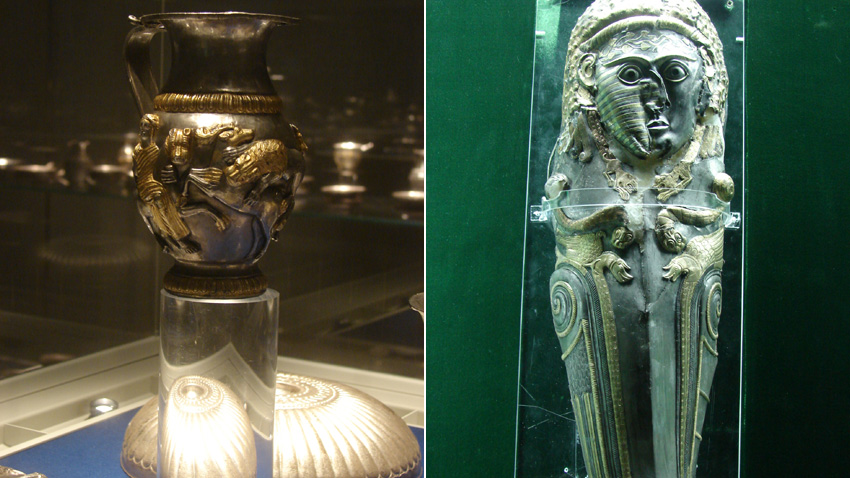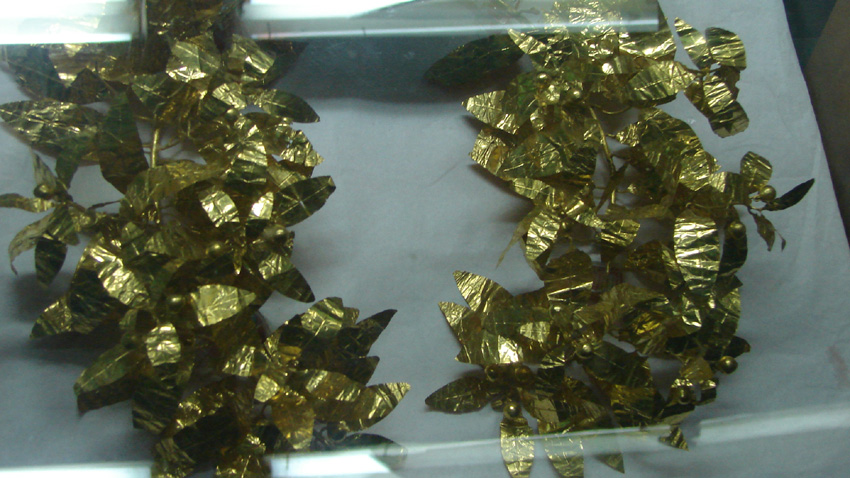 The biggest Thracian treasure, the oldest human skeleton ever discovered in Bulgaria, a clay tablet and a utensil bottom covered in pictograms, described as the oldest script in the world. You can learn more about these and many more intriguing artifacts and see them at the Regional Museum of History in Vratsa, the biggest town in Northwestern Bulgaria. Tracing the past, uncovered by archaeologists will take you on a journey thousands of years back in time. It is no coincidence that the people of Vratsa have chosen as their town’s motto: “A town like the Balkan Range – ancient and young.” The locality called Gradishte, close to Vratsata pass in the Western portion of the Balkan Range is thought to be the cradle of the town.
The biggest Thracian treasure, the oldest human skeleton ever discovered in Bulgaria, a clay tablet and a utensil bottom covered in pictograms, described as the oldest script in the world. You can learn more about these and many more intriguing artifacts and see them at the Regional Museum of History in Vratsa, the biggest town in Northwestern Bulgaria. Tracing the past, uncovered by archaeologists will take you on a journey thousands of years back in time. It is no coincidence that the people of Vratsa have chosen as their town’s motto: “A town like the Balkan Range – ancient and young.” The locality called Gradishte, close to Vratsata pass in the Western portion of the Balkan Range is thought to be the cradle of the town.
“This is where the town originated. It started out as a Thracian settlement founded as an outpost guarding the road here and the copper mines in the mountain which have been exploited since the Copper-Stone Age,” says Alexandra Petrova, curator of the museum. “It then grew into a fortified Roman and then an early Byzantine centre. We have been studying a church dating to the Early Byzantine age. As it turned out there was a Christian necropolis beneath it, totally unconnected with the church. All graves in the necropolis are of children. Later, during the Middle Ages a classical medieval town emerged called Vratitsa. The name is to be found in an inscription in stone found in the vicinity in 1941. The inscription dates back to the 13th century. The town grew along the gorge of the river Leva to reach the limits of the latter-day town of Vratsa.”

Archaeologists have discovered in Gradishte locality ancient and Medieval coins as well as pottery. One of the most interesting finds is a coin from the time of Emperor Zenon (425-491). “It is an authentic forgery - gold plated but inside it is made of bronze. It is gold plated to make it cheaper,” Mrs. Petrova explains. The coin is among the exhibits at the Regional Museum of History, declared one of the 100 national tourist sites of Bulgaria. It is housed in a designated building with several halls, presenting life in these lands from prehistoric times to our day. One of the most glamorous expositions is, of course, that of the Rogozen treasure which has been on display around the world many times. It is the biggest Thracian treasure ever discovered and has been declared the find of the century. The Rogozen treasure comprises 165 vessels: phials, pitchers and cups used for religious rituals in honour of Dionysus, the God of wine.

“The treasure is made of silver and weighs around 20 kg.,” says Alexandra Petrova. “Many of the utensils are made of high-grade silver. Others are oxidized, because the silver is tinged with copper. 131 of the utensils are partially gold-plated. The treasure is connected with a Thracian tribe called the Triballi. They inhabited the lands of what is today Northwestern Bulgaria and were the most warlike of all Thracian tribes. The Rogozen treasure is, in fact, the royal treasure of the Triballi, collected over more than a century. That is why we date it to the 5th-4th century B.C. The vessels are different from a purely technological and stylistic point of view. Some of them were made North of Hemus (the ancient name of the Balkan Range). Others were made South of the mountain, in the lands of the Odrissi tribe. Still others comprise what is known as the loot of Abdera, a Greek colony on the Aegean. Historical sources say the Triballi marched on Abdera and plundered it together with Macedonian troops.”

The tombs in the Mogilan mound, in the town’s old part are also connected with the Triballi. One of the tombs contained the parade armaments of a Thracian warrior: an original gold-plated knee-piece made of silver and an iron helmet. The finds also include the skeleton of a woman thought to be that of the spouse of a local ruler - Herodotus writes about the Thracian custom of the ritual killing of the wife of the ruler. A gold wreath of laurel twigs which adorned the young woman’s head has been preserved to date. The wreath, made of pure gold, weighs 205 grams. The woman’s jewelry featured solid gold earrings, decorated in their lower end with sphinxes and plant ornaments. A chariot with two harnessed horses was also unearthed.

The museum of History also has an Ethnographic and Revival time complex – an exposition dedicated to the annual ritual feasts of the local people. An old church dating back to 1848 as well as three authentic Revival time houses have also been preserved.
“The latest exposition of the Ethnographic complex – the World of Children is on show in one of the houses that has two storeys,” Alexandra Petrova says. “The ground floor shows the life of village children, their toys, all made of natural materials: corn cobs, heads of wheat etc. The second floor features an exposition of the life of children town dwellers. Many of the exhibits on show here belonged to the child of a doctor from Vratsa, who died in its infancy – they include an authentic renovated pram. The complex also features the house belonging to Dimitraki Hajditoshev, a prominent figure in the fight for religious and national independence, killed by the Turks. The Hadjitoshevs were one of the prominent families in Vratsa. The third house presents silk-worm breeding and the silk trade – a traditional livelihood for the people of Vratsa, as well as an authentic reconstruction of a Revival time goldsmith’s. An exposition traces the history of vehicles: carriages, cabriolets, sleighs, made by self-taught cart maker Mito Orozov, a true pioneer in his craft.”
Two of the three authentic 16th and 17th century towers preserved in Bulgaria to this day are in Vratsa. The first, known as the tower of Kurt Pasha, rises right next to the museum and is now a souvenir shop. The second, the tower of the Meschii is next to city hall and is considered the symbol of the town. Once used for defence and accommodation, at the end of the 19th century it was reconstructed into a clock tower. Located at the foot of the Vratsa portion of the Balkan range, the town is also a starting point for hikes to many caves, waterfalls and interesting rock formations in the vicinity.
English version: Milena Daynova
This article is written with the support of the Bulgarian Association for Alternative Tourism (BAAT) under the project “Common strategy for sustainable territorial development of trans-border region Romania-Bulgaria
Photos: Rumyana TsvetkovaA peak situated in the Rhodope Mountains was named after a fairytale character. People call it Znezhanka (Snow white), because it is covered with snow most time of the year. Winter there lasts from November until May. The peak rises some 15..
Veliki Preslav is the second capital of the First Bulgarian Kingdom, Pliska being the first. After the year 893, when it was proclaimed capital of Bulgaria, it became the seat of the first Bulgarian literary school. The town remained a leading..
The town of Pernik is also known as the Miners' Town, or the town of Black Gold, because it grew and turned into a significant industrial center in Southwestern Bulgaria due to the endeavor of the local miners. The only in Bulgaria and the..

+359 2 9336 661
